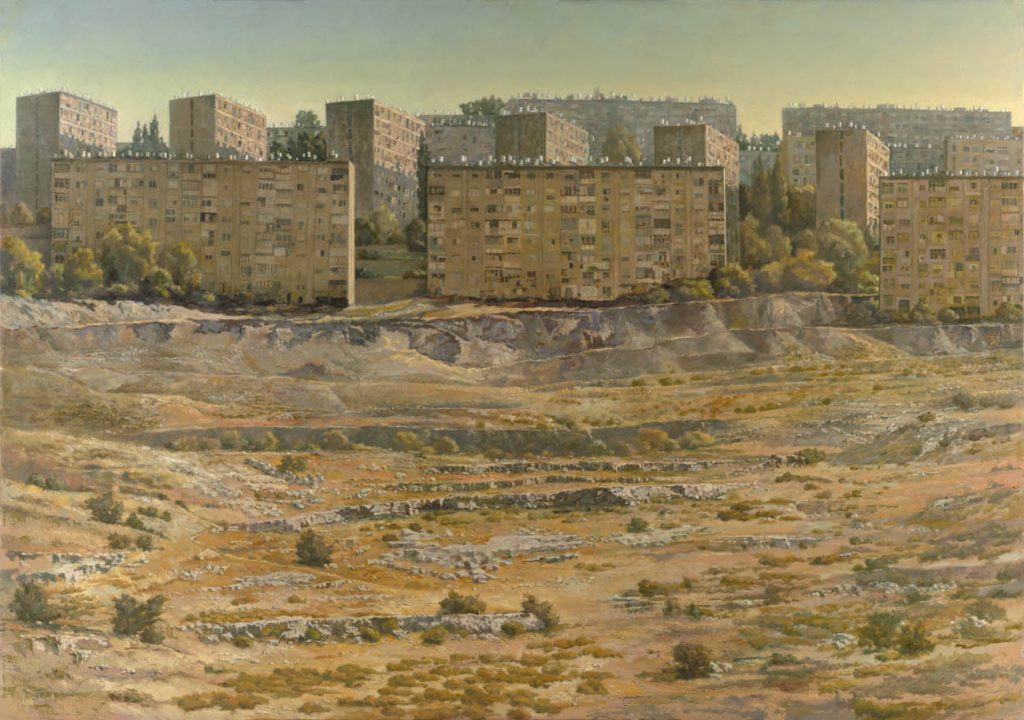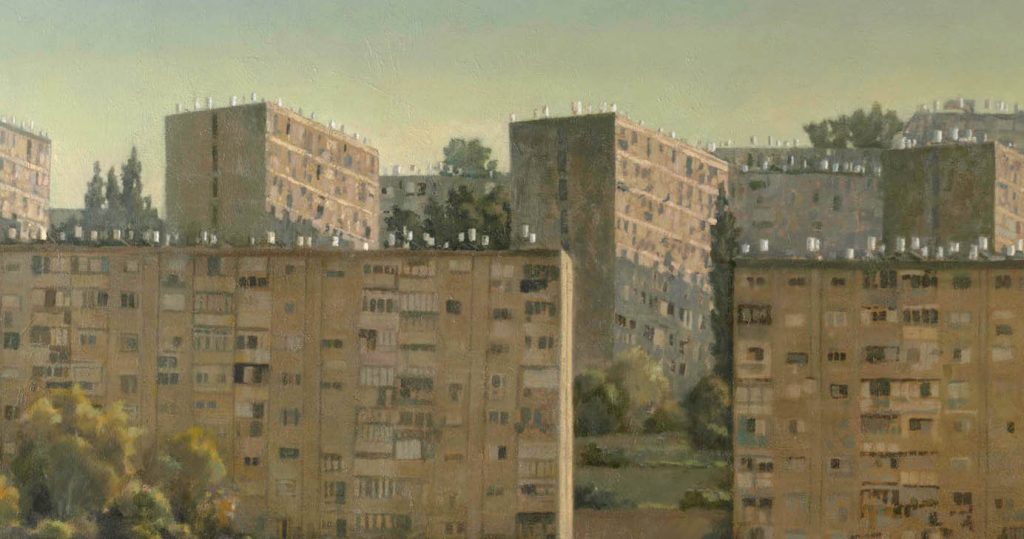Marek: In 2007 they celebrated 40 years (Jerusalem’s reunification) and the gallery I was associated with back then wanted to do an exhibit honoring the occasion. Because I was sure the exhibit would be of gold domes and ultra-orthodox figures next to the Wall, I said I wasn’t going to take part. Yael (Yael Gahnassia the owner of the gallery) said to me ‘No, bring whatever you want to’. Then I remembered that landscape that I’d done years ago, a watercolor, and I decided to paint it again, now, in oil, but this time large, an appropriate painting. I went back to the same place where I’d painted it, years ago, in the morning and did some sketches of the view of the ugliest neighborhoods in Kiryat Yovel, the so-called unaesthetic side of the neighborhoods, in English referred to as “the Projects”, which are actually situated in an enchanting area that I pass through on the way to Tel Aviv, on the road that descends to Ein Karem and from there continues on to the Coastal area. The entire descent was captivating. The ground, the type of rock, the stones and the vegetation it was so typically Jerusalem, I lived in these landscapes. Before ’67 the Mount Zion hillside also looked like this. It was something that was totally a part of the city, and of course its becoming more and more scarce.
I went with an easel and a large canvas to the slope on the other side of the wadi where one could view this landscape at this particular time of day, early in the morning, there it’s to the east. I was allured by something not only from the aspect of the socio-economic significance of these things, but something in their formal organization. At this particular hour of the day, there was a row of dark buildings that faced the wadi towards Ein Karem, and houses standing perpendicular,while behind an entire street is illuminated by the lights of the morning street lamps, and behind those another layer of houses are parallel to these sad, dark buildings, and beneath it all aview of the landscape. This is something that moves me because I’ve painted this landscape in many places, all over Jerusalem. I sat there a few times, I did a very authentic sketch, I began adding markings of color and came back to the studio to continue working on the painting. At one stage when I felt it had reached a point of exhaustion, I showed to my students. I remember, Ora Zack was there, she looked at the painting and said ‘the entire bottom of the painting doesn’t work, it’s perspective is wrong. It’s too bad it doesn’t work, because the top part is so intense.’ So then the entire bottom part, from the cliff downward, I repainted in the studio, from my imagination and from other paintings I’d done. The entire thing is made up. Authentic from the perspective of forms and elements in the landscape, but totally without the thought of copying, rather of also interpreting the perspectives of ‘what’ and ‘how – compositions of how things sit on this slope. Actually, underneath there is another complete painting.
Adi: When we talked about the painting “Breakfast in the Katamonim” you said you really identify with it on the level of a family picture, and that you would have liked to do a series, but not repeat this painting. Then we spoke about how you actually created a conceptual series, maybe not a series, but from the same family, that this painting belongs to.
Marek: True, in the end I live in the Katamonim, which isn’t very different from Kiryat Yovel. Not the old Katemon, but the Katamonim.
Adi: So this is how you experience Jerusalem most of the time?
Marek: ‘Experience’ is quite complex because you experience on many levels. But this is how I live. This is the place in which I live. When I took you to the Yemenites’ street in the Katamonim ( Kanaei HaGalil Street) it was because I live here and I am familiar with it. I suppose there aren’t other painters who would take their students there because they aren’t exposed to it in their real lives. They take the students where they can ‘pose as’.
Adi: If today you were asked to do a painting that represents Jerusalem, ‘A Picture of Jerusalem’, is this the painting you would paint or would you paint something else?
Marek: I don’t think I would be able to take on this kind of order. It’s too much for me. I wouldn’t have done this painting either if I hadn’t been told to ‘go paint’.
Adi: You did it with a bit of antagonism. This is a kind of ‘despite it all’ painting.
Marek: Yes, unequivocally, a “fig” (obscene hand gesture) to the typical Jerusalem nostalgia of gold domes and the Old City with its sentimental alleyways, reporoductions of photos of ultra-orthodox figures at the Wall.
I like it very much, because as a painter I think that I had the luck to do things here that aren’t taken for granted. A painting that appears to be totally realistic neighborhoods, but if you really get close there’s no realism there, it’s pretty abstract. These neighborhoods are picturesque, not neighborhoods of realism. The landscape below as well.
Adi: This is something you greatly encourage in your teaching
Marek: The issue of interpretation?
Adi: Yes
Marek: Yes. Otherwise, what do we paint for? And also, when we look at things and interpret them, then we interpret their life. If it was done from a photograph (and not from observing reality) it would be a reitemion of a photo. It’s difficult to interpret and change something that is already processed and static.
It’s a great painting, I really like it. Without any reference to the ‘despite it all’ it started from.
It’s a painting that deals with rhythms, with compositional decisions. Not only describing what was there.
Adi: You use a model, in order to reach these artistic connections, right?
Marek: The model is a trigger, the reason, but not the goal.
Adi: There are several layers here
Marek: Tell me
Adi: It’s not only an abstract painting of rhythms, it describes a place
Marek: It is abstract
Adi: From close up
Marek: It isn’t even a matter of close and far, it’s the consideration of whether the painting works or not. If it does, then it also works as an abstract. One can create the concept of ‘place’ and it can be only the description of a place. I was lucky that it also came out as a painting that deals with issues of composition, color, relations between shapes, which if hadn’t really existed, rather only the documentation, this would not have been a good painting at all.
Kiryat HaYovel, Marek Yanai, oil on canvas, 161X114 cm


